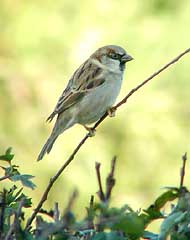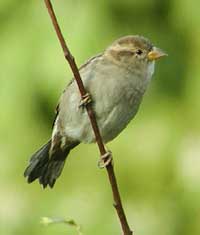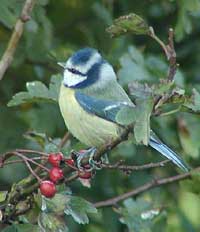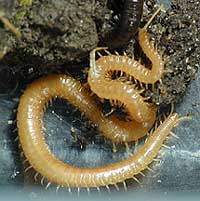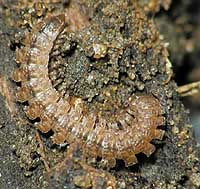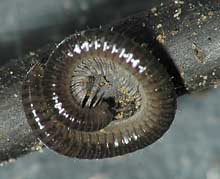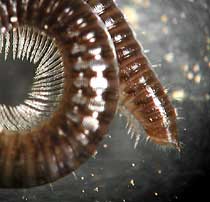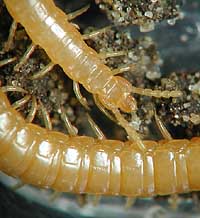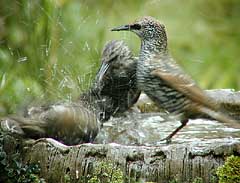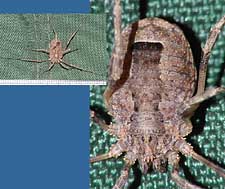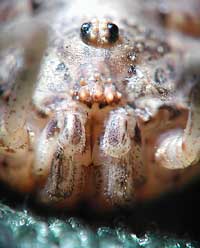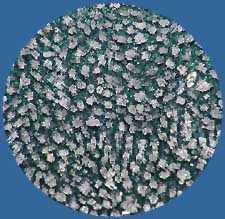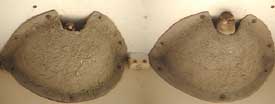Go to latest entry.....................................Go to previous entry2 October - There was some rain during last night for the first time since 9 September, although it didn't do much for the water level in the pond. An encouraging sight in the garden this morning has been the sight of our female Blackbird and two juveniles (not seen for ages) down on the grass hunting for worms. Bird activity continues to be very low key with the Sparrows continuing to be the main attraction, getting quite vocal at times. I'm also starting to hear more from the Robin as it seems to be more actively declaring its territory now. The Dunnock 'family' comes to visit through the day and we have a few Starlings that are regulars. Gone are the days when they descended as a flock on the garden, and we are lucky to see more than three at any one time. There are constantly several Blue Tits about the garden, but I haven't see any Great Tits (or Long-tailed Tits) for a while. The Collared Doves are less active too, although a couple have started to feed here again now. It is sad to note that I have not seen any Goldcrests this year. The line of conifers that ran down the backs of our gardens were their main haunt, and nesting places. In the last couple of years couple of gaps have appeared in that line as people living in the houses built behind them decided to cut trees down - it could be that a couple of feet more garden has been at the expense of a beautiful little bird.
I did snatch this image of a male House Sparrow perched on the top of the Hawthorn. I hoped to get a clear picture of a female as well but they refused to co-operate! The dry weather has had quite an effect on the soil. Under the turf layer the clay soil was very dry and hard, even as I dug down several inches.
Yesterday we had a visit from a male Chaffinch - the first time I have seen one here this side of our Summer holiday. The three Orange Ladybird pupae I have been watching are now down to just one. One died and just shrivelled up, and one just disappeared. The surviving pupa appears to be normal, and I continue to check it.
Here is a female House Sparrow to go with yesterday's snap of a male. These bird pictures have been taken through double-glazed windows (needing cleaning!) so they may not be as sharp as they should be.
The Blue Tits are now much more active at the house end of the garden with three feeding on the sunflower kernels this morning. Here is one of them, waiting on the Hawthorn for its turn at the feeder. I have a camera set up in the birdbox but so far there has been no sign of it being used for roosting by the Bluetits. I have not yet managed to get a picture that shows it, but it seems as though some of the wasps that feed on the ivy nectar (or rotting fruit?) in the garden must be getting drunk. Sheila commented on one that flew into a garden table with such a thud that it attracted her attention. It then stayed put for a while as though dazed before flying away. I watched one crash-landing as it tried to land on the pond weed to drink (see entry for last month). The wasp staggered, fell over several times, got its wings wet and wandered round on the duckweed before taking off at the fourth attempt and flying away in a decidedly unsteady fashion.
6 October - The weather remains gloriously sunny and I have been away from home for most of the day, but I must record the emergence of the last known Orange Ladybird on the Birch tree. It had already emerged when I went down to check the pupa for the first time at 8.20am, so it looks as though I have lost my last chance to photograph the process for this year. This one had entered the pre-pupal stage back on the 15th September and so has taken 22 days to metamorphose as opposed to the 15 days taken by the last one I photographed, perhaps a reflection on the gradually cooler temperatures as we pass through Autumn.
9 October - Another bright, sunny morning as our good weather continues, although the evening before last we had some heavy rain for a short time. There were still dry patches under the shelter of plants and the pond level did not rise much so it probably sounded more than it really was. It was enough to give the frogs a reason to spread out for a few hours! One amusing discovery I made yesterday morning concerned a spray of artificial cherries. Sheila had stuck the spray, complete with wire stems, rubbery cherries and silk leaves, into a tall flowerpot that has a bamboo growing in it. First thing in the morning I found the spray torn apart and the 'cherries' scattered over the grass, with some of them split open! It didn't look like the work of a bird, would a fox have been responsible?
11 October - The camera has remained unused over the last few days as other things have distracted me. Yesterday I collected my Land Rover Discovery after its conversion to run on LPG (LP Gas) instead of petrol. First impressions are good, but the real test will come when we head for Cornwall again in two weeks time. The weather is increasingly autumnal now, colder and more often than not, cloudy. Although the rain has held off since Monday evening it is forecast for later today (still dry at 10pm). My neighbour Bob tells me that he saw a Woodpecker here last week. I haven't seen one in the garden for a couple of years, but I have recently heard woodpecker drumming from the direction of the Brickfields Park. I was fiddling with the Discovery at around 5pm and was treated to a brief garden visit by a couple of Long-tailed Tits - they are entertaining to watch and their calls are unmistakable in the garden. There was also another rare sound in the garden, the squeeky call of a toad, although I was not able to see it, let alone get a photograph.
12 October - Well, the rain came in the night and early this morning, but today has been dry and we are going into a blue sky evening with just a few small clouds that might light up with the sunset.
The first one measures over 7cm long when extended. The head end is near the top of the picture. I think it is Haplophilus subterraneus. It is a geophilid centipede - geophilid means 'ground-lover'. I read that it has between 77 and 83 pairs of legs. It is the only British centipede that can cause damage to plant roots. There are other centipede species living in the garden but I'll need to find those another day.
This first one is about 15mm long and seems to be Polydesmus angustus. These can grow to about 25mm long, although I didn't find any longer than this one. It is one of the flat-backed millipedes and usually feeds on rotting leaves etc. They look very much like centipedes, until you spot that two pairs of legs emerge from each body segment.
The picture shows the millipede in the coiled position it adopts when disturbed. The head is at the inside of the coil.
A closer shot shows the 'tail' more clearly. In addition, the legs look quite feathery, and there appear to be bristles sticking up along the millipede's back, between segments. I must blame different lighting conditions for the apparent change in colour of the body! I have still to get a close-up of the head - it is always either moving too fast or it is hidden. While trying to get that millipede close-up I managed to get this one of the tail and mid-sections of the centipede. Again, the head has so far escaped me. If you look closely at the enlarged version of the picture you may see that there are shiny rounded objects attached to two of the legs near the centre of the picture. I am wondering if these are mites or ticks. Perhaps I will look more closely tomorrow.
14 October - Well, The weekend saw both the weather and me go downhill, me with a rotten cold and the weather turning wet, windy and colder - at least the ponds have been filled! I'm afraid that other than returning the millipedes and centipedes to the garden, and filling the bird feeders, the garden has been left to its own devices. On the bright side, the rain will soften the ground (the clay was like rock last week) before I endeavour to returf an area at the bottom of the garden later in the week.
This afternoon there was what has become a very unusual event in the last year - Starlings having a communal session in the birdbath. There were five of them (and a Sparrow), but it was down to these three by the time I got my camera sorted.
17 October - Sunshine has returned this morning along with the coldest start so far this Autumn, with an outside temperature of 5C at7.15am. No photograph, but last night I saw a hedgehog in the garden for the first time in months.
18 October - Colder again this morning with the temperature just under 4C at 7.30am. A few drizzly periods through the day were interspersed with sunny periods.
Its body measures about 10mm long, typical of an adult female (the male being smaller) and the second, longest pair of legs are about 23mm long. These legs are used as antennae by the harvestman.
This second image is an attempt at a close-up of the 'head' of the harvestman, with its pair of eyes perched in a raised 'turret at the top. If I can find more info about the harvestman I will add it later.
19 October - A sunny, cold start to the day with the thermometer reading just above 0C at 8am and the first frost of the year. There is the thinnest film of ice over the birdbath and the upper surfaces of the car are covered with an almost uniform layer of tiny ice crystals, a few of which are pictured here.
20 October - A brief entry today just to note a spectacular Sparrowhawk attack. One of our peanut feeders has an anti-squirrel cage around it and there was a sparrow feeding inside the cage. The Sparrowhawk attacked, wings flapping and hanging onto the cage with one foot while it used the other to extract the unfortunate victim. It flew down to the ground in front of the Hawthorn and adjusted its grip on the sparrow, saw three of us watching it and flew off before any photographs could be taken.
24 October - After several, miserable, wet days yesterday and today have been very pleasant and mainly sunny. This morning started with a frost. A couple of days ago I caught an all too brief glimpse of a Jay at the top of the leylandii and yesterday the Sparrowhawk paid another visit while I was in the garden. It perched on the fence by the Hawthorn for about a minute before being distracted by Collared Doves several garden away. I think it left the area empty-handed. I am now getting ready to head for Cornwall for a week by the sea again, so there will be no new entries until I return. |
|
